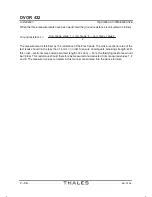
DVOR 432
Installation
Operation and Maintenance
2-34
Ed. 01.04
The network should be laid as symmetrical to the DVOR station as possible. The necessary length
and extension when laid in a straight line, should be estimated from the basic data below.
Strip length
Ground resistance
25 m
10
W
50 m
5
W
100 m
3
W
2.6.3
Ground Rods
Ground rods are either pipes or U, L or T-shaped profiles driven vertically into the ground and 1 to
2 m in length. It is necessary to connect several ground rods together in order to reduce the grounding
resistance. The minimum spacing is twice the length of each ground rod.
Material: Steel (hot galvanized)
Pipe
30 x 3 mm
Bracket
L 65 x 65 x 7 mm
U-profile
U 65 DIN 1026
T-profile
T 60 DIN 1024
Probable grounding resistance of a rod:
Length 1 m approx. 70
W
Length 2 m approx. 40
W
The material, cross sectional areas and grounding resistance of the connecting leads to the shelter
should be as for strip ground conductors, (see Section 2.6.2). When pipe-type grounding rods are
fastened with clamps, screws at least M10 in size should be used.
2.6.4
Ground Plates
Ground plates are solid perforated sheet metal plates with dimensions of approx. 0.5 x 1 m or
1 x 1 m, which are embedded vertically in the ground. The top edge of the plates should always be
at least 1 m below the surface. Several ground plates must be connected in parallel in order to reduce
the grounding resistance. The minimum spacing should be 3 m. Material:
Sheet steel (hot galvanized)
min. thickness 3 mm
Sheet copper
min. thickness 2 mm
The ground resistance of a plate 1 m
@
is approx. 30
W
. The data for the connecting conductors is speĆ
cified in the tables in Section 2.6.2.
2.6.5
Estimating the Ground Resistance
The resistance of each rod, each plate and each supply line used should be determined on the basis
of Section 2.6.2 to 2.6.4. They should be considered as parallel resistances. The resulting grounding
resistance should then be calculated as follows:
1/R
res
=1/R
1
+1/R
2
+1/R
3
+...+ R
n.
Taking into acĆ
count the nature of the terrain (for factors see Section 2.6.1) satisfactory grounding conditions can
be assumed if the ground resistance calculated from the base data is < 5
W
. If the value calculated
is 5
W
or more, we recommend measuring the ground resistance.
Summary of Contents for DVOR 432
Page 2: ......
Page 4: ......
Page 16: ...DVOR 432 Table of Contents Operation and Maintenance X Ed 01 04 ...
Page 38: ...DVOR 432 General Information Operation and Maintenance 1 6 Ed 01 04 ...
Page 40: ...DVOR 432 General Information Operation and Maintenance 1 8 Ed 01 04 ...
Page 46: ......
Page 66: ...DVOR 432 Installation Operation and Maintenance 2 24 Ed 01 04 ...
Page 74: ......
Page 136: ...DVOR 432 Installation Operation and Maintenance 4 32 Ed 01 04 ...
Page 172: ...DVOR 432 Repairs Operation and Maintenance 6 22 Ed 01 04 ...
Page 186: ...DVOR 432 Repairs Operation and Maintenance 6 36 Ed 01 04 ...
Page 192: ...DVOR 432 Installation Operation and Maintenance Annex Nextfield AN 4 Ed 01 04 ...
Page 194: ......
Page 196: ...DVOR 432 General Operation and Maintenance Annex Nextfield L 2 Ed 01 04 ...
Page 204: ...DVOR 432 Alignment Procedure Operation and Maintenance Annex Nextfield AN 14 Ed 01 04 ...
Page 234: ...DVOR 432 Maintenance Operation and Maintenance Annex Nextfield AN 44 Ed 01 04 ...
















































